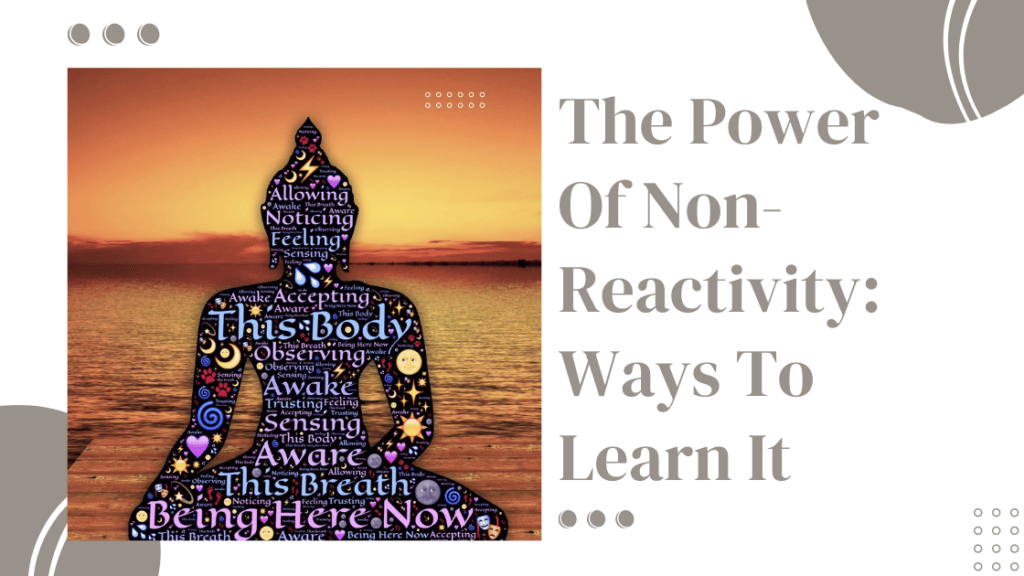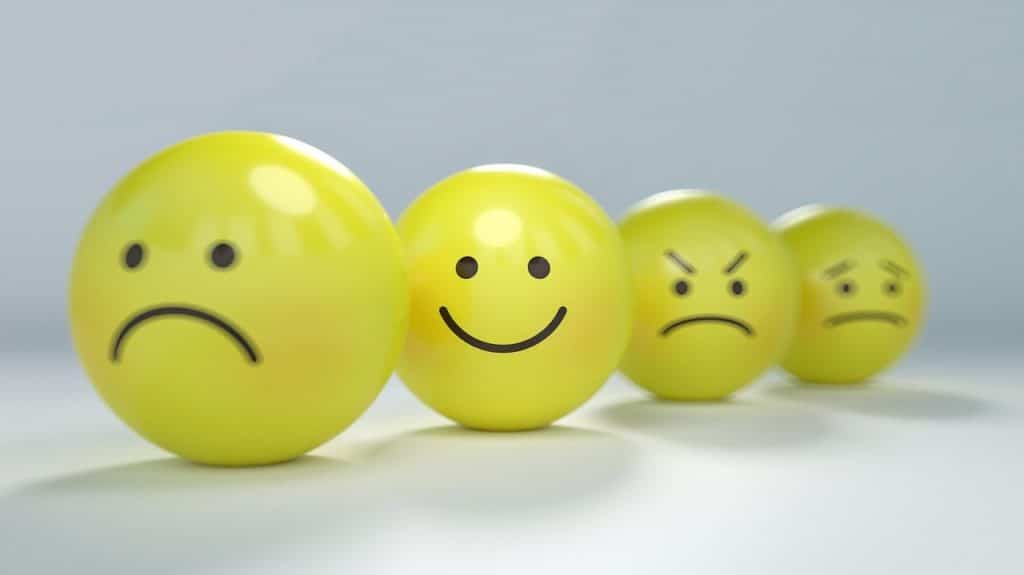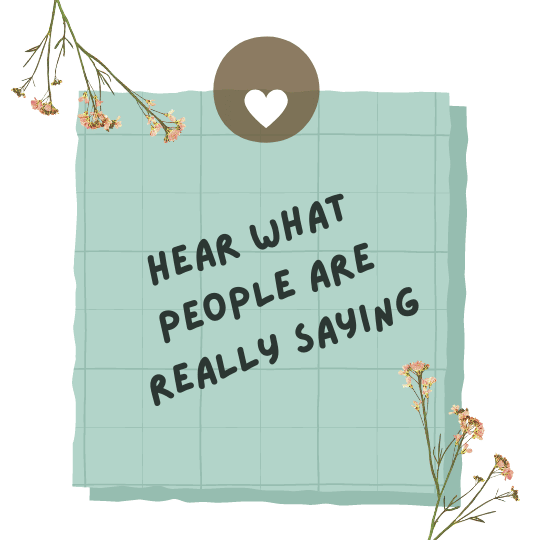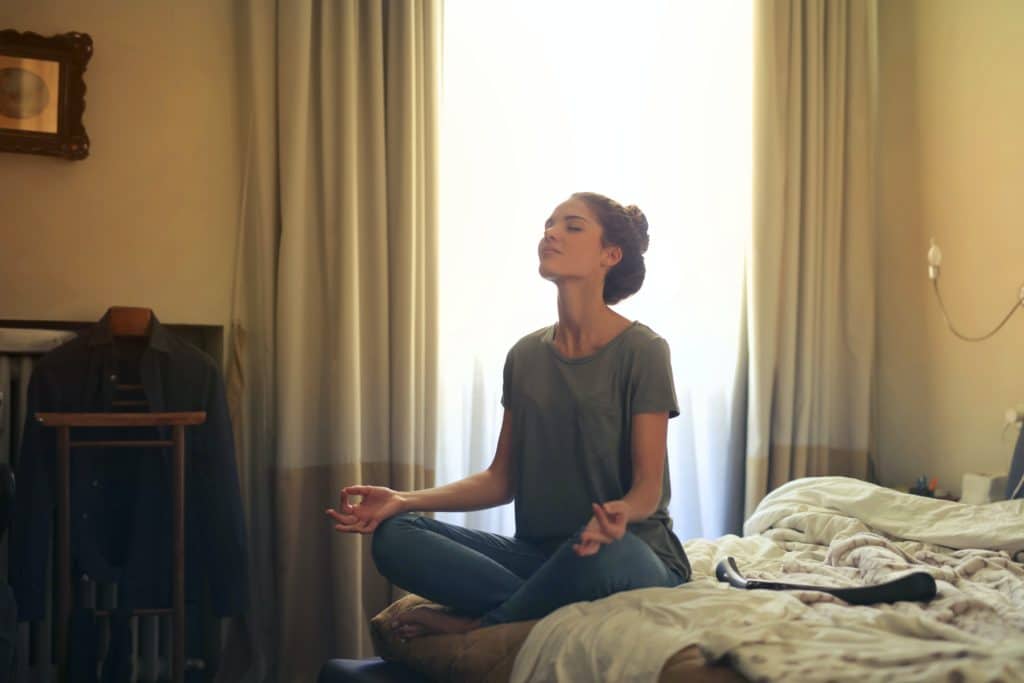We live in a reactive world.
Our phones buzz with notifications, our email inboxes are constantly overflowing, and we’re constantly bombarded with demands on our time. We react to the news, traffic, and our co-workers, among other things.
It’s no wonder that we often feel overwhelmed and stressed out. The good news is that there’s a way to break free from the cycle of reactivity.
It’s called non-reactivity!
Non-reactivity is one of the most important skills you can learn to ensure you lead a peaceful and happy life.
Hence this article!
In this blog post, we will explore the power of non-reactivity and 13 ways to cultivate it in your life!
Here’s what you’ll learn:
Let’s get right into it!

What is Non-Reactivity?
Non-reactivity is the ability to not let your emotions control you.
It’s a state of inner peace. It’s about staying calm in the face of adversity and not getting wrapped up in the drama of life.
Non-reactive people can maintain their peace of mind no matter what is happening around them. They don’t allow their emotions to dictate their actions or reactions.
Why is Non-Reactivity Important?
To explain why non-reactivity is important, I’ll start with a short story about something that happened to me.
A few days ago, I almost got into an accident.
I was walking out of a coffee shop and about to cross the street. As I was about to step onto the road, a car rushed past me, almost knocking me down.
Instinctively, I yelled at the driver to watch where he was going. He, in turn, started hurling insults at me as he drove away. This time I didn’t respond to him and walked to my car.
However, this situation got me thinking.
- What would have happened if I didn’t react to the driver’s actions?
- What would have happened if I hurled insults back at him?
This is where the power of non-reactivity comes in.
Reactivity causes a chain reaction. If I had not yelled at the driver and applied some of the techniques discussed later in this article, he wouldn’t have reacted the way he did.
It all started with me. If I had not reacted, the whole situation could have been avoided.
Non-reactivity has also been linked to better stress response. In a 2020 study, researchers found that non-reactivity could theoretically buffer stress reactivity, leading to new responses to stressors and triggers.
Non-reactivity also helps you avoid feelings of regret and guilt. My reaction to the driver left me with regret, leading to me questioning my actions.
If I had not reacted, I would have avoided those negative feelings
Non-reactivity is also essential because it allows you to stay in control of your life.
If you’re constantly reacting to the events and people around you, you’re not really living your life – you’re just reacting to it.
Another benefit of being non-reactive is that you’re less likely to make impulsive decisions. You can think more clearly, and don’t allow your emotions to control you.
With non-reactivity as a skill, you take back control and live your life on your own terms.
It’s like having a superpower!
Now that you understand the power of non-reactivity, let’s look at 13 ways to cultivate it in your life!
13 Ways To Cultivate Non-Reactivity
#1. Consciously Choose To Relax Before You Respond
This is one of the most important techniques that you can use to respond to a situation non-reactively.
When you feel yourself getting tense or worked up, take a few deep breaths, and relax your body. This will help you clear your head and see the situation for what it is.
By consciously choosing to relax before responding, you’re training your mind and body to react differently to stressful situations.
Over time, this will become second nature, and you’ll be able to respond non-reactively without even thinking about it!
This technique is instrumental when dealing with difficult people or situations.
So, the next time someone cuts you off in traffic, take a deep breath and relax your body before you honk your horn or hurl insults at him.
Related: 10 Best Emotional Intelligence Coaches & Checklist
#2. Pause and Seek Clarity
When you’re in an intense argument, it’s easy to say things you don’t mean.
Before you react, take a pause, and seek clarity. This means taking a step back from the situation and gathering all the information before making a decision.
If you’re unsure what the other person is trying to say, ask them to clarify. You could also use these communication techniques to help avoid any misunderstanding.
This will help you avoid misunderstandings and react in a way that is non-threatening and non-defensive.
Remember, it’s always better to seek clarity than to make assumptions!
And when seeking clarity, be open to the idea that you might be wrong.
#3. Identify Your Triggers
We all have triggers. Things that set us off and make us react negatively.
Identifying your triggers is essential so you can work towards avoiding them. Knowing what triggers you could also help you learn how to respond to them in a non-reactive way.
Some common triggers include:
- Feeling disrespected,
- Feeling belittled,
- Feeling threatened, and
- Feeling like you’re not being heard.
Once you know what your triggers are, you can start to work on non-reactively responding to them.
For example, if feeling disrespected is a trigger for you, you can start to practice non-reactivity by consciously choosing to relax and seek clarity when someone does something that feels disrespectful.
#4. Don’t Take Things So Personally
This is easier said than done, but it’s important to remember that not everything is about you.
When someone says or does something that bothers you, take a step back and see the situation from their perspective.
Ask yourself why they might have acted that way. Is it because of something you did? Or is it because of something that’s going on in their life?
Remember, you can’t control what other people do or say. All you can control is your reaction.
Instead of taking things so personally, focus on responding calmly and constructively.
Also, remember that not everything is about you.
Related: Ways How To Stop Your Reactive Anger
#5. Label What You’re Feeling
How are you feeling? Are you angry, afraid, feeling hurt, or disappointed?
Labeling your emotions can help you understand why you’re feeling them.
Once you know why you’re feeling a certain way, it will be easier to respond non-reactively.
For example, if you’re angry because someone cut you off in traffic, you can remind yourself that it’s not a big deal and that there’s no need to get worked up.
Labeling your emotions will also help you communicate how you’re feeling to others.
Instead of saying “I’m fine,” try saying, “I’m feeling frustrated because I don’t feel like my needs are being met.”
This will help the other person understand how you’re feeling and why.
And it will also help them to respond in a way that is non-threatening and non-defensive.

#6. Practice Mindfulness
Mindfulness practice is the act of being aware of the present moment’s experiences and accepting them. It’s about being present with your thoughts, emotions, and sensations without judgment.
When you’re mindful, you don’t get lost in your thoughts or reactions. You’re able to observe them without getting pulled into them.
This is a useful skill to practice because it will help you non-reactively respond to your triggers.
For example, if you’re feeling triggered by a situation at work, you can take a few deep breaths and focus on the present moment. You can observe your thoughts and emotions without getting caught up in them. And then respond to the situation.
A Mindfulness practice takes time to build, but it’s a valuable skill to learn if you want to react to situations in a non-reactive manner.
#7. Before Responding, Write Down Your Response
When feeling triggered, it’s easy to react without thinking. However, if you take a few moments to write out your response, you’ll be able to respond non-reactively.
Writing your response will help you slow down and think about what you want to say. It will also help you consider the other person’s perspective.
And it will give you time to calm down and respond in a non-reactive way.
So next time you’re feeling triggered, take a few moments to write out your response before saying anything. You might be surprised at how much more effective your reaction is when you’ve had time to think about it.
#8. Express What You Need, Then Stop
Non-reactivity doesn’t mean never letting your needs known. It’s okay to express what you need. In fact, it’s essential to do so.
However, once you’ve expressed what you need, stop talking. This is where many people make the mistake of being reactive. They keep talking and trying to convince the other person to see their perspective.
But when you keep talking, you don’t give the other person a chance to respond. You’re also not allowing yourself to observe the situation.
So next time you’re in a situation where you need to express your needs, stop talking. See how the other person responds and go from there.
#9. Practice Active Listening
Active listening is a communication skill that involves listening and responding to what the other person is saying.
It’s about being present with the other person and hearing them out. It’s also about understanding the other person’s opinion and not allowing your emotions and biases to interfere.
This is a useful skill to practice because it will help you respond to situations in a non-reactive way.
For example, practice active listening if you’re in a meeting and someone is presenting an idea you disagree with. Hear them out, then respond once you understand their views.
Don’t interrupt them or try to talk over them. And don’t allow your emotions to get the best of you.

#10. Practice Silence
Of all techniques discussed in this article, this is one of the hardest.
In our society, we’re used to filling silences. And when we’re feeling triggered, we want to say anything to improve the situation.
However, there are times when the best response is no response. When you’re feeling triggered, take a moment to breathe and be silent. This will help you calm down and non-reactively respond to the situation.
#11. Practice Forgiveness
This doesn’t mean condoning bad behavior. It means letting go of the anger and resentment you’re feeling.
When you can forgive, you’re no longer a victim of your emotions. You don’t have to react to them.
And when you don’t have to react to your emotions, you can respond to a situation in a non-judgmental and non-reactive way.
So, practice forgiveness if you find it hard to respond to a situation non-reactively. It will help you let go of the emotions that are clouding your judgment.
#12. Practice Equanimity
How do you respond to the good and bad in life?
Do you get too caught up in the good moments and become attached to them? Do you dwell on the bad moments and let them affect your mood?
Or do you respond to both the good and bad with stability and a sense of calm and peace?
When you have equanimity in life, it’s difficult to get triggered and respond reactively. Since you approach every moment with peace and calm, you can respond non-reactively to whatever life throws your way.
#13. Practice Meditation
Meditation is a practice that helps you become more aware of your thoughts and emotions.
It allows you to see them for what they are – just thoughts and emotions. You just let them pass and don’t have to react to them.
With non-reactivity meditation, you learn to let go of thoughts and emotions, making it easier to respond to situations in life non-reactively.

Bonus: Seek Professional Help
If you’re struggling to respond to situations in your life non-reactively, it might be helpful to seek professional help.
A therapist can help you understand the emotions that are driving your reactions. They can also provide guidance on alternative ways to respond to situations.
And it’s not only therapists!
You could also seek the help of a mindfulness or spiritual coach to help you learn and practice some of the techniques discussed in this article.
Related: Emotional Reactivity – 5 Ways To Be More Mature
FAQs About The Power of Non-Reactivity
What Is An Example Of Non-Reactive Behavior?
An example of non-reactive behavior would be if someone were to cut you off in traffic, and instead of getting angry and honking your horn, you let it go.
You don’t let the situation affect your mood or ruin your day. You respond in a non-reactive way by not allowing the emotions to take over.
Another Example of non-reactive behavior is if someone were to say something hurtful to you.
Instead of getting defensive or lashing out, you take a step back and understand where they’re coming from. You don’t react to the situation but respond in a non-reactive way.
How Does Non-Reactivity Help With Anxiety?
Anxiety often results from overthinking and ruminating on past events or worrying about future events.
When you’re non-reactive, you don’t dwell on the past or worry about the future. You live in the present moment and take each situation as it comes.
This helps to reduce anxiety because you’re not constantly thinking about what could have happened or what might happen. You’re just living in the moment and dealing with whatever comes your way.
Non-reactivity also helps to reduce anxiety because you’re not constantly reacting to your thoughts and emotions.
You’re able to let them pass without giving into them. This allows you to live a less emotionally charged life, which can help to reduce anxiety.
What Are The Benefits Of Being Non-Reactive?
Some of the benefits of being non-reactive include:
- Improved mental and emotional wellbeing
- Reduced stress and anxiety
- Increased peace of mind
- Improved relationships
- Better decision making
You Don’t Have to Respond to Every Situation
There you go.
Thirteen ways to cultivate non-reactivity in your life. We hope the techniques discussed in this article will help you lead a more non-reactive life.
Which of these techniques will you introduce to your life to be more non-reactive? Do you know of any other ways to be non-reactive? Please tell us in the comment section below.
If you have any questions about non-reactivity or would like to share your experiences with us, please reach out in the comment section below. We would love to hear from you!
And remember, you don’t have to respond to every situation. You can choose to observe it and respond non-reactively. Just let it be and move on with your day.
